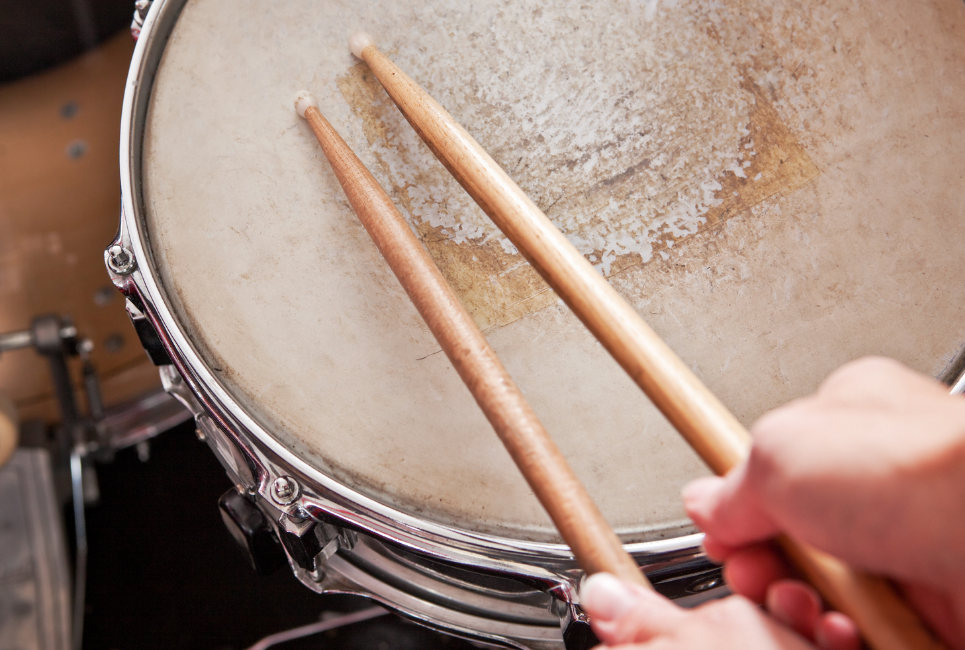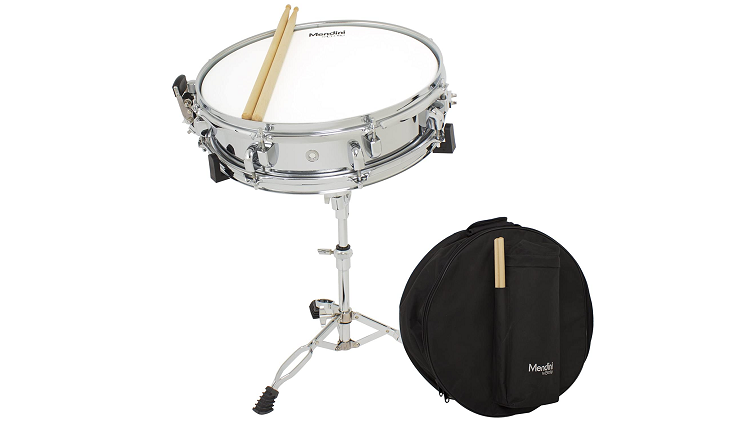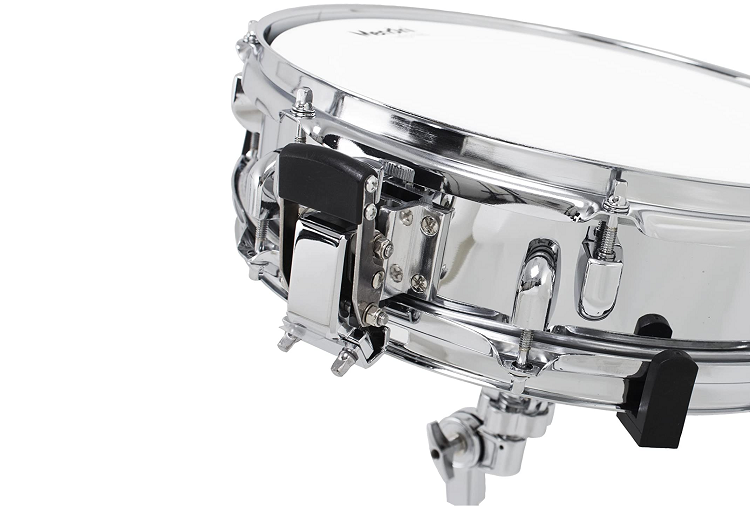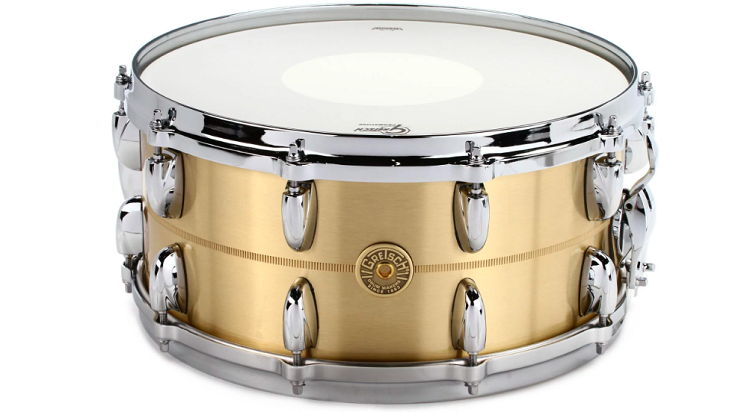- Lights, Camera, and Action: How to Film and Edit a Drum Cover - May 31, 2022
- The Best Wuhan Cymbals: A Comprehensive Buying Guide - May 30, 2022
- Alesis Surge vs Command Compared - April 26, 2022
From leading soldiers into wars to being the central hub of any modern drum kit, snare drums have been a part of our culture for centuries now. It all began with legendary drummers like Ringo Starr and Neil Peart, who pushed their eclectic drum tones into the limelight.
These days, everyone from Chad Smith to Taylor Hawkins continues to impress us on the cans. The spirit of music has been growing exponentially amongst amateur musicians for decades now. For many, a set of drums isn’t just about creating music – it’s also about letting your freak flag fly and having some fun while you are at it.
As you’d expect, drums that come with a bigger price tag also feature a better quality of components and overall construction. High-end snare drums generally offer a wider tuning range and flexible tone. In other words, they’re fit to be incorporated in both studio and stage settings. As you go down the price ladder, expect to see some cutbacks from the manufacturer’s end.
Low to mid-tier drum brands will try to cut corners any way they see fit, but most of them settle for cheaper shell materials and/or hardware components. In addition to the shell material, you also have to consider the wood type, each of which will affect your tone in a unique fashion.
There is a range of materials to consider, including wood, metal, and some hybrids, so make your choices wisely. The size of the drum shell will also impact your drum tone’s character, too, so remember to factor that into your decision process.
Whether you are looking for something warm and rounded, or something that will replicate the thunder of a marching band, there’s a lot of great brands to choose from. And of course, Mendini is one of them. If you are looking to add the Mendini snare drum to your existing rig or a custom build, then I’m here to point you in the right direction.
What to Look for in a Snare Drum –
The choice for a new snare drum is never easy. Or to put it lightly, there are so many different types, it’s impossible to tell which one sounds the best. The ability to understand which type of snare drum sound will fit your mix comes with years of ear training.
It takes a lot of trial and error for drummers to advance to the stage where they can confidently point to a suitable drum tone. To better understand how the sound of a snare drum is created, we have to first dissect the instrument and observe each component individually.
To make this easier for you, though, I’ve made a short compilation of the factors that affect your snare drum sound the most. These include:
- The Shell Material
- The Drum Heads
- Its Overall Thickness
- The Size and Shape of the Shell
- Its Tone Control Accessories
- The Included Hardware
The Shell Material
The drum shell material plays a critical role in how your drums will sound. While some brands prefer sticking to the same type of wood and ply across the entire shell, you will come across a lot of hybrid models too, which combine wood with acrylic (or other similar plastics).
The two most popular types of woods used for constructing drum shells are maple and birch, although drum kits are certainly made from a variety of different woods. Depending on the prominence of low-end articulation and power you want in your drum tone, the right choice of wood can fluctuate between birch, mahogany, maple, ebony, oak, or poplar.
Drums made out of maple are especially known for their distinctive articulation in the low end and overall sonic power. Birch and poplar, on the other hand, which are commonly found in budget drum sets, exude a lot of dynamics in the high-end but lack low-end detail.
If you are interested, do look into drums made entirely from metal too, which feature an incredibly bright tone with a quick and snappy attack.
The Drum Heads
The drum heads play a vital role in creating and sustaining resonance inside drum shells. It also happens to be the one component that you will be striking a lot while playing drums. In order to get the most appropriate sound, dynamics, feel, and feedback while playing, you have to work with the right kind of drum heads.
Be it clear, coated, double, or single-ply, make sure to try them all out at least once before you add them to your kit. It goes without saying that the overall tuning stability of your kit will also be affected by the type of drum heads, so keep that in mind when putting together a drum kit.
Coated drum heads tend to compress the sound a bit and also scoop out much of the high-end, making them an appropriate choice for situations that demand a warm and smooth tone. Clear drum heads, on the other hand, will emphasize your high-end resonance, resulting in a bright and colorful tone.
Depending on what the mix demands, make your choice about drum heads skillfully. Remo, Evans, and Aquarian are just a few brand names off the top of my head that make great quality drum heads.
If you are new to the world of drumming, keep in mind that cheaper drum heads tend to lose their “fresh out of the box” sound rather quickly. You will also find yourself tuning them more often than premium drum heads, which are more resilient to tuning and rattling issues.
Its Overall Thickness
Believe it or not, but altering the shell thickness can radically change the character of your drum tone. Generally speaking, the shell thickness is determined by the level of ply enforcement used in its construction. Some brands use multiple layers of wood to add more stability and sustain, while others use single-ply to achieve a brighter and more dynamic tone.
I’ve found a sweet spot between 6 to 8 ply levels, which seems to produce a versatile and lossless drum tone. Then again, the choice for tone is completely subjective, so there are no right or wrong answers here.
Nevertheless, if you are one of the few ones who prefer a dark and gloomy drum sound, I’d suggest doubling up on those plies in order to muffle the sound. Adding more plies does boost the durability of the kit, too, so that’s another plus point for you.
The Size and Shape of the Shell
To help you better figure out what works best for your setup, it’s important to understand how sound travels inside a drum shell.
As you can probably imagine, more room leads to more resonance, overtones, and inevitably a ton of dynamic richness. In general, snare drum sizes range from 12” to 16”. A 12” snare drum tends to sound more compressed, but the sound seems to open up more as you go up in size.
Its Tone Control Accessories
If you are looking for a quick fix to manipulate the resonance, sustain, or tuning of your drums, then you are going to need some extra accessories.
This can include things like drum gel, which allows you to quickly manipulate the resonance of your drums without having to repeat the entire tuning process. Something like this can really save you a lot of time and effort in a recording situation.
Drummers looking to experiment or record with a variety of tones on the same drums can make use of tone control rings. This clever piece of equipment fits around the outer perimeter of your drums and will allow you to change the tone of your drums without taking the entire thing apart.
Last – but not the least! – the most efficient sound damper I’ve found in all my years of playing is just a good old pillow. Stick that fluff inside your drums and forget about making too much noise or any unnecessary overtones. I wouldn’t recommend you try this in a studio with a $3000 kit, but if you are at home jamming with your buddies, feel free to take my advice.
The Included Hardware
Many drummers don’t realize the impact and relevance of hardware elements in a drum kit. For instance, the bearing edges will influence your drum tone more than the drum heads you have on. The Standard 45 is commonly found in rock and metal kits which are designed to deliver more attack and sustain.
On the other hand, the Double 45 is used to emphasize harmonics, while a 45 with roundover and the vintage roundover are warmer, which is why they are used to emulate a vintage drum tone. Other hardware elements of your kit (like the stand, key, and pedals) should also be taken into consideration as they will define the quality of your experience.
Once you’ve established a budget and ticked out all the above checkpoints, all that needs to be taken care of is the aesthetics. I’ve always been an advocate of good-looking drum kits, solely for the fact that looks can be so inspiring.
So with that out of the way, let’s take a look at some expert tips, which I’m confident will provide some additional assistance with your snare purchase.
Best Drum Set – My Expert Decision-Making Tips
- You might be disappointed if you get yourself the same model of snare used by your idol drummers and expect it to sound the same in the mix. Instead, I’d suggest you go for a snare drum that flows well with your existing kit. A lot of things can be manipulated in the post, and with a good sound engineer, the sky’s the limit for you.
- The size of drum shells is more important than you think. The dimensions of your snare drum will define the boundaries of the headroom, resonance, and the overall dynamics of the tone. Make sure you know what size of drums will sound good for your music before investing in them.
- If you are looking for a drastic change in your snare tone, consider changing the shell type that you are currently working with. So, if your snare is wood, check out what a metal snare sounds like, and vice versa. This will give you a bigger picture of how snare drums work and which sound suits you the best.
- Bearing edges will have a huge impact on the sensitivity and feedback of your drums so don’t forget to factor them in your buying decision. Sharp bearing edges result in high sensitivity and more overtones being produced. On the other hand, rounded bearing edges will scoop your sound and give you a more warm and passive response.
- It’s important to remember that, as a beginner, proper tuning will play a major role in any type of snare sound you are trying to achieve. Keep a drum key handy on you at all times to make sure your trusty snare never snaps way out of tune.
- Last but not the least, if you’ve bought yourself your dream snare, make sure to get a proper drum case to store or lug it around. This will not only protect the finish, but it’ll also avoid any unwanted accidents which could damage the hardware and bearings.
Mendini Snare Drum Set Review
If you’ve recently started to climb the ropes of drumming, or you just need a solo snare drum for busking or something along the same lines, then the Mendini snare drum set will do you justice. The Mendini by Cecilio Student is designed for learning musicians and those on a tight budget.
What’s Included in the Kit?
The Mendini snare drum set includes:
- A snare drum (at 14” x 5.5”)
- Ten lugs
- An adjustable 25-inch to 30-inch snare stand
- Rubber practice pad to mute the drum’s sound
- Padded gig bag, sticks, and adjustable neck-strap
From what I could tell, the snare drum is made from premium components that are easy to assemble. The kit also comes with its own custom-made gig bag, a pair of drumsticks, and a neck strap. The snare stand does not feel cheap, even though it’s part of the complementary accessories.
Unlike many other budget snare drums, this one doesn’t suffer from any rattling or tuning issues, either. The sound is quite chirpy and bright in my opinion, but not too glassy, which is quite an achievement for a product in this price range.
I was surprised by the sound quality, to say the least, and did not come across cost-cutting measures of any sort.
Young drummers and their parents are going to rejoice at the value for money you get with the Mendini snare drum set. It’s a reasonable investment for parents who fear their kids might change their minds about drumming in the future.
If it turns out that your child does want to continue their hobby, then you will always have the option to incorporate this snare drum into a full-size drum kit.
Once completely assembled, the entire kit weighs around 18 ounces. Even young children can hang the drum around their necks without the risk of fatigue or cramps.
No doubt, it’s very cheap for a snare drum set, but that rarely crossed my mind in all the time I spent with it. For what it’s worth, the snare drum comes with a warranty period of one year against manufacturing defects.
Pros
- Best value snare drum
- Comes with all the required accessories for a beginner
- Solid build quality and tone
- Comes with a practice pad to mute your sound
Cons
- This is not a good option for serious drummers who are looking for a top-notch snare tone
- The finish is not very inspiring
Other Alternatives That I’d Recommend
Yamaha Stage Custom Birch Snare
The Yamaha Stage custom snare drum is a great alternative to the Mendini snare drum set, both in terms of price and sound quality. The Japanese manufacturer is well-known for making some of the most sophisticated musical instruments other than drums, so rest assured because you are dealing with the best in the industry.
Sound-wise, this snare drum has a well-rounded, warm tone but the resonance I was getting from my strikes was second to none in this price range. The warm nature of this tone can be credited to its 6-ply birch construction which is primarily found in vintage drum kits.
I had no complaints in the build-quality and construction department at all. Being a Yamaha, I can assure you that you are getting your hands on a snare drum that was built to last. It’s amongst some of the least expensive snare drums, but don’t let that price tag fool you.
All of the components look and feel like they were built using the best materials. It’s worth mentioning that Yamaha allows you to get this kit in several color combinations, all of which look beautiful.
Pros
- Great build quality
- 6-ply birch provides great depth to your snare tone
- The looks are quite stylish and modern
Cons
- Low-mass slugs are great for sustain but take a negative toll on tuning stability
- Not built for studio use or advanced drummers
Gretsch Drums Silver Series
Most of the options we’re discussing today lie in the budget category, which is why I felt it was about time to bring out one of the bad boys of the snare drum world.
The very first thing that strikes you about this snare drum is undoubtedly going to be its unique finish and construction. I’ve quite possibly never seen a snare drum more beautiful than the Gretsch Silver series.
This snare drum uses brass which squarely lands its tone somewhere between wooden and metal snare drums. This is an intelligent choice for drummers who are looking for a bright and snappy snare tone without the shrilling overtones of a metal snare drum.
The die-cast hoops add an extra layer of stability to the snare drum, and the rest of the hardware looks pretty robust too. The brass shell creates a huge dynamic range with a crisp attack and a thumpy low end. The snap-in drum key holder makes sure you’ve always got the tuning bit under control at all times.
This snare can cut through the mix like a knife, which is why you’ll often encounter it on countless metal and rock albums. This is, without a shred of doubt, the most unique sounding snare drum I’ve ever played. And that hammered finish truly accentuates that feeling for me.
You may have already figured this out from the description I’ve given so far, but this one indeed lies on the far end of pricey snare drums. But you do get what you pay for, so it’s a win for you in the end. I cannot recommend this snare drum enough to all kinds of drummers… provided you can bear the price tag.
Pros
- Brilliant looks and finish
- Incredibly versatile sound and response
- Robust build quality
Cons
- A bit on the expensive side
- Not suitable for musical styles like jazz
Mapex MPX
The second all-birch snare drum on this list is the very reasonably priced Mapex Birch MPX. This is a 14” x 5.5” snare drum that is squarely aimed towards learners and those on a tight budget. This comes with Remo drum heads as standard, and the shell is made from all-birch.
It produces a distinctive tone with a nice amount of depth and a surprisingly snappier attack. I felt like the tone was flexible enough to go along with a variety of different musical genres, which is an excellent quality for snare drums to have in this price range.
With a proper setup and some careful tuning measures, you can easily drag this snare drum through some of the biggest challenges of drumming. I really liked the aesthetics of the drum too. The all-black birch shell construction seriously pops at first sight due to the silver hardware.
I’m not a big fan of Remo heads, but the one that came with this kit felt extra stiff to my taste. Intermediate drummers should definitely look into replacing the heads with a better quality third-party solution, as it would no doubt help bring out the best features of this snare drum.
All things considered, if you are a beginner and not sure of what this hobby could lead to, get the Mapex MPX snare drum and you won’t regret the choice you’ve made. Its all-around sound, complex construction, and great build quality will keep you occupied for years to come.
Pros
- Stylish finish and hardware
- Great value for your money
- Flexible tone, which suits a variety of musical styles
Cons
- Stock heads did not sound good to my ear
Frequently Asked Questions
Question: What is the Most Appropriate Angle to Place a Snare Drum?
Answer: If you were riding a bike, the snare drum would be the handle. If the handle was too far to the left or right, it would be very hard to ride. Position your snare drum with a somewhat similar intent. It should be placed right in front of you, ideally at an equal distance between your feet.
I usually get the position of the three fundamental components right first. There are:
- The bass drum
- The hi-hat
- And the snare drum
The rest of the kit will be built around those units. Remember, don’t get ahead of yourself and start planting the cymbals or the rack toms already before you’ve got yourself a basic layout of the entire drum kit.
Set the throne at a comfortable height so your legs fall perpendicular to the floor, at a 90-degree angle. Position the foot pedals so your feet rest naturally on them. This is when I bring in the snare drum and place it so it rests equal distance between the pedals and my legs. Having a highly adjustable drum throne makes this easy.
Question: What Snare Drum is Best for Metal?
Answer: Due to the sharp and bright nature of their tone, snare drums became the staple of the metal music industry. From warm and luscious to bright and snappy, drummers go for a variety of drum tones to enrich their metal mixes these days.
Traditional heavy metal and thrash metal drummers have been known to use metal snares to get that loud, abrasive tone that really pops in the mix. These can also be spotted in some of the more aggressive sounding sub-genres, such as doom metal and death metal, where drummers are trying to achieve those intense breakdowns.
Modern metal genres, such as progressive metal and djent metal (for lack of a better term), are highly dependent on dynamic snare tones. These tones could range from super warm to ultra-bright, depending on the sound palette one is trying to capture.
In such scenarios, it is common for drummers to go for versatile drum shells which are able to put out a variety of tones. The Supralite snare drum from Ludwig would be the perfect example of what I’m referring to.
Question: Which Snare Drum Should I Use for Playing Jazz?
Answer: We don’t need to remind ourselves how important it is for jazz musicians to get their sound right, so let’s get to the point right away. If you are looking for the authentic sound of a 60s jazz bebop kit, you unfortunately won’t get it from a shell that was not specifically made for this purpose.
Wooden shells are more popular in the jazz scene because they offer drummers more tonal control over their sound. That being said, some unconventional bands have and still to this day continue to use metal snares for playing jazz. You could say that, as a general rule, wood is more popular than metal because of its warmer and well-rounded tone.
Most jazz drummers tend to go for single-ply coated heads for their snare so they can get a reasonably high-pitched tone without losing out on any of the low-end detail. Their responsiveness is also something that drummers tend to favor for playing complex jazz beats.
Remember, a snare drum is only as good as its ability to stay in tune. Tuning will make a huge difference in the way your drum responds and sounds in the mix, so as long as you have your basics covered, you can make any snare drum sound good for a jazz setup.
Question: How Often Should I Tune My Snare Drum?
Answer: As the majority of the hits landing on a snare drum tend to be quick and exaggerated, it will naturally detune after being played for a while. If you’ve just unpacked your new snare drum, chances are it will be out of tune. I’d suggest you make some minor adjustments and tune it before you start playing.
To the trained ear, it is much easier to pick up on when the snare drum starts to go out of tune. As a rule of thumb, know that your snare has snapped out of tune when it no longer sounds crispy and naturally bright.
To quickly check this, try to play the same note in two different positions. So for instance, if you hit the head 2” from the left edge, it should sound the same when you hit the head 2” from the right edge. Sometimes the sound will be uneven and that’s when you’ll know, the tuning is off with the drum.
A lot of drummers don’t pay enough attention to the resonant head, or the bottom head, which is technically responsible for creating the optimum resonance inside the shell. Even though you are not hitting this surface at all, you would need to tune the resonant head from time to time to help maintain that classic snare drum tone.
Question: Who Makes the Most Expensive Snare Drums?
Answer: This is a bit controversial, but the most expensive snare drum ever sold was a $2 million drumhead that belonged to the legendary Ringo Starr. That’s not to say that you will have to fork over millions to get your hands on a decent snare drum.
The most desired and high-performance snare drums are created by the likes of DW, Gretsch, Ludwig, Pearl, and Tama today. An individual snare drum will easily cost you over $1000, as they are built with the best components by highly proficient engineers.
My Final Thoughts
So if you are looking for a loud, bright, and aggressive sounding snare drum which doesn’t break the bank, get yourself the Mendini Snare Drum Set. This is a perfect tool in my opinion to learn the fundamentals of drumming without waking up your entire neighborhood, and I definitely recommend it for beginners.
There are some really standout features about this kit that are the best in their respective category. When you combine that with the complementary accessories you get with the kit, it leaves no doubt in my mind that this is one of the best beginner snare drum sets out there.








